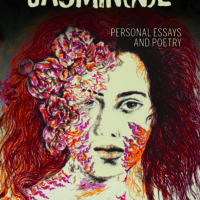In Jasminne Méndez’s book, Night-Blooming Jasmin(n)e, we return to the poet’s familiar dilemma: grief. But this time, Méndez places grief in the context of the body and asks: What happens when the source of grief comes from within?
Méndez explores this question and more in an oscillation between prose and poetry. Most of the book’s content performs in narrative, but in both her essays and lyric poems, Méndez illustrates through personal experience the haunting consequences of a divide between spirit and body. She gestures toward the necessity of resilience for people of color. And perhaps most important to the book’s development, Méndez simultaneously performs and subverts labeling, questioning its influence on identity—an investigation particularly important to “an Afro-Latina Dominican raised in the Deep South.”
From the very beginning, Méndez introduces her reader to labels as subjective concept by titling each of fives sections of the book according to types of Jasmin(n)e: “Spanish Jasmin(n)e” focuses on the question and necessity of identity; “Red Jasmin(n)e” introduces motherhood as a conflict; “Summer Jasmin(n)e” illustrates the difference between the hungry body and the body’s hunger. The fourth section, “Winter Jasmin(n)e,” returns to the major catalyst of the collection, Méndez’s battle with scleroderma, and transforms one of its symptoms—cold and numbing limbs—into a devastating but well-conceptualized conceit. Finally, the fifth section, “True Jasmin(n)e,” focuses on three main R’s: reclamation, reassembly, and recognition.
The section “Spanish Jasmin(n)e” begins with loss, or at least loss conceptualized—mourning the “I” lost in the process of grief. The sources of this grief are many but are eventually rooted in illness: “I tried to blame scleroderma. I tried to blame lupus.” This loss is important to understand why labeling/identity is important to this speaker; she is trying to piece together who she once was before the markers were made arbitrary by the presence of a new label: scleroderma. Essays like “Diagnosis” translates the word scleroderma for all its meanings:
Scleroderma is:
_____heavy joints on a rainy day that keep you from washing your hair
_____or brushing your teeth or opening a jar
These moments provide context to readers unfamiliar with the illness, but also demonstrate how wide the brush of scleroderma is as it paints the speaker like a canvas. No wonder, then, this speaker repeats over this section what she is called. In “Skin Score,” for instance, Méndez writes:
I liked the way he called me “Mina,” when I answered calls. Mina, short for Yamina, what he heard Mami call me over the phone once.
Or in the opening line of “Poet’s Jasmin(n)e”: “Now Lupe calls me Amo.” For a speaker redefined by illness, the arbitrary markers of self become vital.
In “Red Jasmin(n)e,” Méndez reveals that her ailments make conception nearly impossible. We join the speaker after a miscarriage. We learn first about her searing yearning to be a mother, and then we learn about her body’s refusal to yield to that yearning. Perhaps the most devastating essay to convey this dilemma is the micro essay “Not Yet,” which situates its speaker in the lobby of a doctor’s office with a mother and her daughter. The speaker chats with the young girl, and during this chat we watch as the speaker confirms she would be “a good mom.” But as the essay comes to a close, we are reminded, as the speaker is reminded, that longing isn’t always enough.
Similarly, the poem “Dar a Luz” illustrates a new but equally distressing position for the speaker, when she is forced to bear the news of una comadre’s pregnancy. Méndez writes:
________________I hide
the evidence of envy in my tear ducts.
I offer us a child-proof
smile.
The most haunting part of this section is the new, implied question it poses: What happens when grief is all the body can bear?
Méndez’s third section, “Summer Jasmin(n)e,” introduces hunger: What is the spirit hungry for? Hope? “Little white lies,” according to the aptly named poem, “Hunger.” But what is the body hungry for? According to Méndez, the body is hungry for the body.
Here, Méndez’s body, or at least the metaphorical representations of it, feasts upon itself. She describes its hunger as “Gluttony: Undigested.” She describes its hunger as a wolf that “bit the side of my face. / Her spit flood[ing] my lungs.” The work most representative of this section, “Interruption,” blurs the lines between prose and poetry, so that even the seams between sentences are eaten away.
The fourth section, “Winter Jasmin(n)e,” transitions further into conceit, developing a previously mentioned symptom, numb and blue fingers, into avalanches and cold: “split fingertips slipped on slopes & drowned / in dry ice.”
Finally, Méndez closes her collection with an attempt toward reclamation, reassembly, and recognition. Night-Blooming Jasmin(n)e begins in loss, so it makes sense that Méndez would end the book by reclaiming what was lost.
One of the section’s representative essays, “Hope,” focuses on Méndez’s and her family’s journey to reclaim the abstraction. In the journey, they pray, ritualize, and stretch their bodies through several yoga poses, until Méndez discovers that the loss of self she experienced was not an ultimate or permanent loss. Rejuvenated by a reacquaintance with her own strength, Méndez ends her book by picking up the pieces once shattered by grief. This is a good read for anyone who hates to leave a book feeling unresolved.
Night-Blooming Jasmin(n)e is ambitious. It tugs at your heart throughout its fully realized arc. The images in “Mouth Sores,” or the found poetry of the mango names in “Heridas,” suggest that Méndez has all the tools to create meaningful, surprising meditations if she chooses, and yet, in some of Méndez’s meditations, the core significance of each essay lands on something personal but strangely expected. Other essays occasionally lack performance—and by performance, I mean the markers of sating prose: lush but relevant description, scenes over exposition, a judicious use of dialogue.
That said, I didn’t read Méndez’s book for a performance. I chose to read the book because I had read few books by women of color about chronic pain, and as a black woman suffering her own bouts, I went into Méndez’s book looking for solidarity. Anyone looking for that same comfort will find it here.





